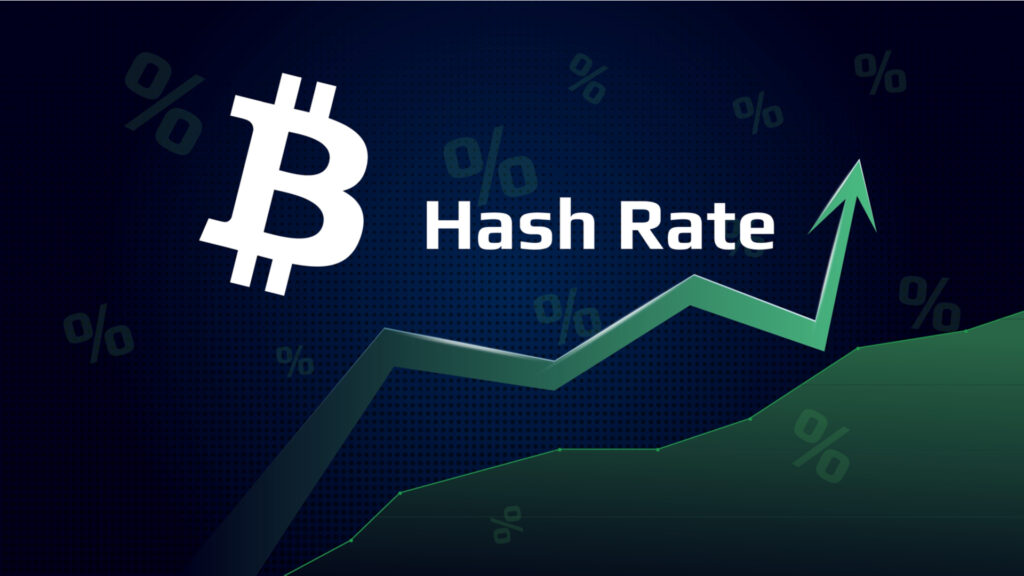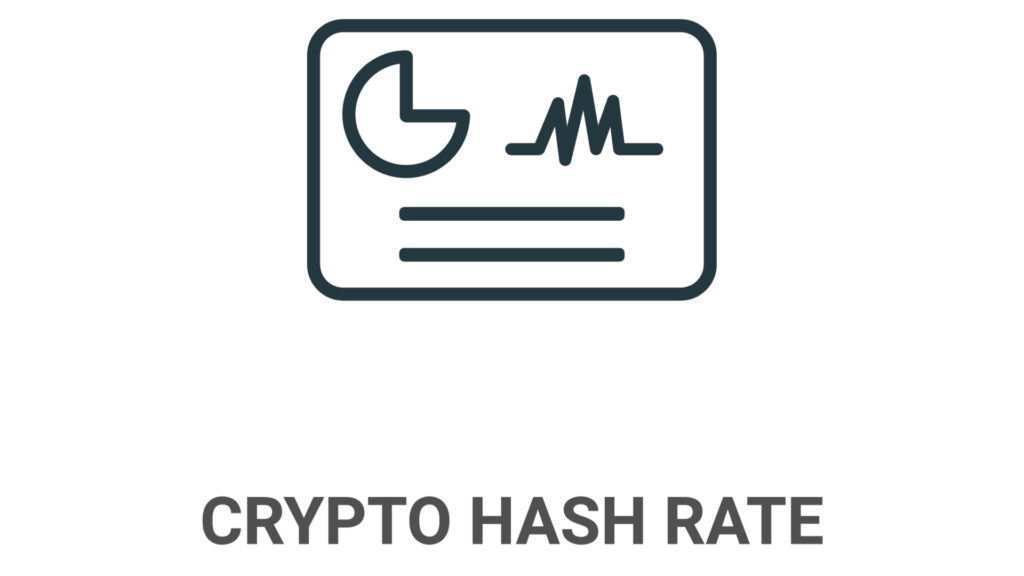The term “hash rate” is closely associated with cryptocurrencies and blockchain, yet it rarely gets explained in almost any article dedicated to the topic. The following article will discuss the hash rate definition and everything you need to know about it to invest or mine for maximum profit.
What is a hash rate?
Hash rate measures the total processing power of a cryptocurrency network needed to process blockchain transactions. In simple terms, hashrate means how fast a crypto machine can perform the necessary miner's calculations and solve the required puzzle to complete a transaction.
In essence, all hashes are codes of randomly generated letters and numbers that identify a unique piece of data. Since in a proof-of-work blockchain, the highest reward goes to the miner who solved the block of data (hashing) first, it turns out that the higher the hash rate of their equipment, the more likely they are to take first place. Other miners also authenticate new hashes by measuring them within the blockchain network. Once a hash passes the appropriate validation, it gets added to the chain. The miner will receive its crypto winning. It also makes the network more stable and protected from hacker attacks.
Proof-of-work, and therefore hashing, is currently used by two of the best-known cryptocurrencies – Bitcoin and Ethereum. Apart from them, Dogecoin, Monero, and Litecoin operate on the same principle.
What is it used for, and why?

What does a hashing assessment do besides understand whether your hardware can provide you with fast and efficient cryptocurrency mining? In fact, the actual purpose of a hashrate is vast and is vital to both miners and investors. For example, this metric allows you to evaluate the following:
- The power of the miner. Those who want to participate in Bitcoin mining vitally need expensive equipment with the resources to solve hashes like, but not limited to, SHA-256. The dynamic complexity of this cryptocurrency is so great that today it requires additional systems and machines, such as ASIC miner, which speed up the processing of a few mega hashes per second to a thousand of mega hashes!
- Blockchain network power. The GPU hash rate also acts as an indicator of system performance: the more miners with powerful hardware, the more powerful the network is because their power is summed up and provides all internal processes. For example, the total hashing rate of Bitcoin is 110 PH/s, which is a kind of record in the world of cryptocurrencies.
- The size of the likely reward. Knowing the hashing speed of the network, miners can predict how much profit they will receive if they participate in block verification. However, one must remember that it is not the network's total power that is most important but the power of an individual computer, so the hash rate for the miner himself may vary most. Additionally, the newer the hardware and software, the higher the rewards tend to be.
- The level of network security. We mentioned already that the hashrate increases the system's resistance against external attacks. It works like this: the more miners compete and participate in cryptocurrency mining, the more decentralised it is, and the less likely the entire network will fail.
- Mining complexity. The higher the hashing rate, the higher the demands on miners and their equipment, and transaction processing and block resolution become increasingly complex. Sometimes, the complexity reaches such a level that it becomes impossible for individual miners to mine cryptocurrency without cooperating, as they alone cannot give the network the speed it needs.
- The popularity of cryptocurrency. Clearly, the more miners want to participate in its mining, the higher the demand for it, and vice versa. A blockchain network evolves and is introduced into related fields (e.g., banking) if its processing power exceeds that of large companies. That is how Bitcoin became the first currency in which even the authorities started investing.
Some experts also believe that a cryptocurrency's price depends on its hash rate. However, there is no direct evidence for this. Moreover, if there is any correlation, it is only in the short term, when there are sharp ups and downs in the market, additionally triggered by other events. Nevertheless, the hash rate does increase along with Bitcoin prices, but it does not have a significant impact that could help investors in forecasting.
Network hash rate: how to measure the rate

Hash rate is the number of calculations a computer performs in one second. This number can be as low as a few tens of units or as high as quintillions. It depends on the power of the hardware used and the requirements of the blockchain network itself. The following speed-per-second designations are standard:
- ·kH/s (kilo/s) – the number of hashes in thousands
- ·MH/s (mega) – number of millions
- ·GH/s (giga) – in billions
- ·TH/s (tera) – in trillions
- ·PH/s (peta) – in quadrillions
- ·EH/s (exa) – hashes in quintillions
The denomination depends on the rules of a particular network and the number of miners participating. Bitcoin, for example, uses the SHA-256 hashing algorithm, which measures the hash rate in quintillions, i.e. exa (EH/s). Ethereum, on the other hand, uses tera, i.e. TH/s.
You can calculate the hash rate by using special services like CryptoCompare.
How the hash rate of cloud mining is measured
Cloud mining is quite different from classic mining because it does not depend on the power of the miner's equipment, but on the amount of hashrate the data centre provides. Thus, the miner is not mining the cryptocurrency themselves, but are only “sponsoring” the mining and receiving dividends for it. So, they can neither measure nor influence the network's hash rate. But, of course, you can only do this at the start, when choosing a data centre, when selecting a service with a specific hash rate is possible.
What is a reasonable hash rate?
The conventional wisdom is that the higher the hash rate, the better for the miner (assuming they have the right equipment for such speeds), the network, and the investors. After all, a high hashrate means a high transaction and block resolution rate. Thus, as of October 28, 2022, BTC's hash rate reaches 254.393 EH/s, the highest among cryptocurrencies. Therefore, any value close to that would be a good hash rate for mining.
Bitcoin hash rate
The blockchain is the foundation for Bitcoin, the first and most popular cryptocurrency today. Any blockchain, in turn, is made up of a chain of interconnected blocks, any change in which inevitably leads to a change in the entire network (making fraudulent transactions and spurious transactions impossible). What are these blocks? They are files that hold information about all transactions made on the network.
The smaller the blocks are, the fewer resources they require to be processed and verified by miners looking to generate new coins. That is, in practice, the blocks are sets of data which need hashing as a process of confirming their integrity and validity. New BTC coins, in this case, are given to miners as a reward for helping to do this validation.
As mentioned earlier, Bitcoin uses one of the newest crypto-technologies available, the SHA-256 cryptographic algorithm. It allows the network to convert incoming data into a 256-bit string and thus measure a one-way hash rate. As a result, the network's overall speed (power) gets calculated in the following way: the average time of block extraction is compared to the complexity of the network at the moment. Thus, if the average hashrate is 1 bit/s, about one billion block validations can be performed every second.
What the hash rate depends on

The hashrate that you will be able to achieve and thereby predetermine the efficiency of your mining depends on the following factors:
- Video card. That is the graphic card hash rate, which depends directly on the parameters of the card itself and its novelty. The overclocking parameter is essential. That is, how much can you increase your video card's performance manually? And how safe is it? Here it would be best if you were a professional so that the equipment will not simply burn out and deprive you of profit and the warranty period for the goods. Miners often buy video cards from Nvidia: 6700xt, 6800xt, and 6900xt, but also RTX 3090, 3080 or 3060.
- Mining programme settings. The miner can also install additional utilities or automate the settings, but this can, on the contrary, reduce the hash rate.
- Farm equipment. The larger the farm you purchase from a particular company, the larger and faster the hashing is, usually.
- Stability of your Internet connection. Of course, you won't be able to provide your hardware with good power if your connection to the blockchain network is constantly interrupted. It can also include continuity of power. In a sudden power outage, the hashing process will get reset.
How to increase the hash rate
How can you increase the hash rate in mining? Since the hashrate directly affects the profitability of mining and the hash rate fluctuates frequently, many are wondering how to influence these fluctuations and increase the hash rate without completely replacing the hardware with more powerful and up-to-date machines.
So, the hash rate can be increased by modifying the BIOS system and increasing the clock frequency with a power limit. The MSI Afterburner utility will also help the video card gain overclocking. The main thing is to increase the frequency and adjust the values gradually to avoid stability lapses.
Crypto miners who use GPU Rigs and ASICs can increase the hashrate by increasing the computational speed through overclocking. However, exercise extra caution here: such an overclock may conversely reduce the actual hash rate if the number of confirmed blocks becomes lower than at a moderate speed. It will also increase the power consumption of the equipment and the risk of early hardware failure.
The best way to determine the mining efficiency is to use the pool statistics, since the average hashrate is usually equal to the solution enumeration rate, information about which can easily be given to you by the mining utility. If you are dissatisfied with the efficiency, changing the server or joining collective mining is better.